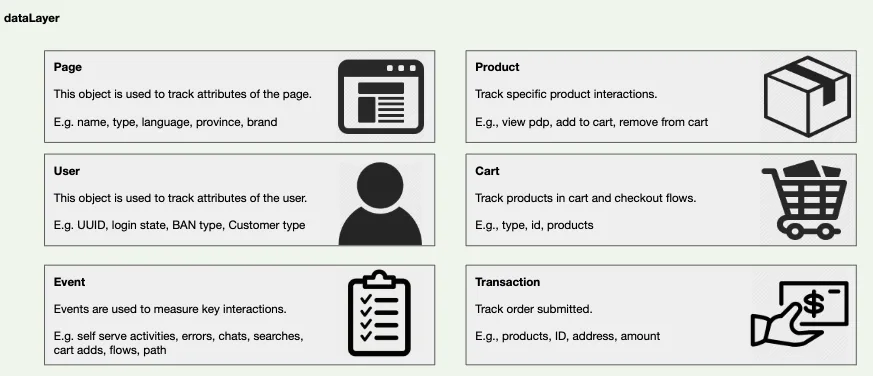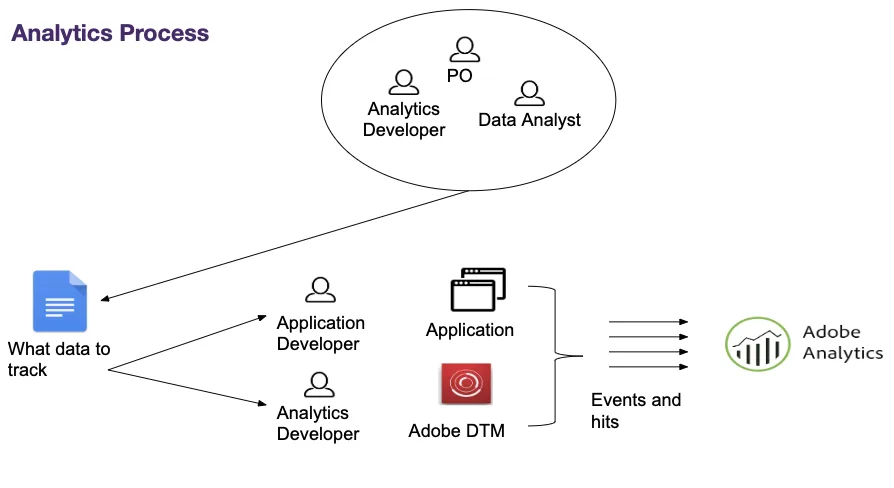Mastering the web analytics journey at TELUS
Data Intelligence · Mar 21, 2019
Although TELUS Digital has experienced exponential growth moving from a team of 20 to 450, the core principle of being driven by data has always remained the same:
Principle 2.0: Value data over opinions
The best decisions are those that are informed by customer and team member feedback. We build products with results we can measure, informing our decisions with data rather than just listening to the loudest voice in the room.
As TELUS Digital and TELUS continue to grow, the Data & Insights team was faced with a challenge: how could we democratize data so team members felt empowered to access and action it quickly, easily and regularly on their own? And with this newfound ability, how could team members bring about meaningful changes to our customers? Having a dedicated team was great, but we could run the risk of working and using these applications in a silo.
"We were coming from a world of siloed systems where it was difficult to harmonize decision making and insights. We needed to consolidate and we wanted processes to scale digital experiences/personalization and data-driven decision making end-to-end." - Dinesh, Director of Analytics
In this post, I’ll walk through the last two years of how our team took key tools in the Adobe suite and created a process to form actionable insights for team members across TELUS to use. I’ll share lessons learnt from scaling a team of 2 analytics developers with a huge backlog to building a core team of 8 (and growing).
Democratizing data vs democratizing value
TELUS has used tools like Domo to democratize the data across the enterprise. For example, when a customer lands on a page, the data would be sent to Adobe Analytics, which would then be funnelled to Domo. Domo is a great, user-friendly tool that allowed us to share these insights with different teams members at TELUS who weren’t analytics savvy.
However, these teams were missing out on the huge potential of using other action-oriented Adobe tools. Domo allowed them to see the data, but tools like Adobe Workspace, Adobe Target or Audience Manager were the missing piece of the puzzle in understanding and serving the diverse needs of our customers. In other words, once they saw the data how were they going to action it? One of the blockers to this was that teams didn’t really understand the analytics pipeline so datasets were siloed and difficult to access.
Setting up a solid process
Before we could start actioning our insights in tools like Adobe Target or Audience Manager, we had to set up a clear process for our teams to follow, along with solid documentation. David and I quickly took to designing a dataLayer schema, which would help us create a ‘north star’ from which we could evolve. We started with 6 buckets to track - luckily for me, David had already gotten a head start with the support of a couple of Adobe consultants:

This would mean that every page across TELUS.com would have to at minimum surface “Page” data that would be collected by our tag manager. By building this into our starter kits, we’d simultaneously ease the developer experience and built the bedrock on which we built our implementation process.
With a clear and concise schema in mind, we turned to Adobe consultants who recommended DTM (Dynamic Tag Manager) over Ensighten for its dataElement change functionality (pooling on the dataLayer object allowing us to detect changes).
Implementing our plan
Our team was well aware that there were many different ways to set up, track and scale analytics in an enterprise. Implementing dataLayers would be an investment, but one our team was willing to take on. Over the next 8 months, we’d roll out a dataLayer to 100% of newly built pages, backtracking and covering old pages in the places we could as well. All in all, 85% of our pages on TELUS.com were tagged and the core areas of the business were satisfied with the data collected.
"We saw a change in how our data was collected, with a more holistic schema in the back of everyone's mind. We were able to create enough freedom for the implementation team to build custom tracking for different applications but also maintain some order to allow the analysts to build holistic reports." - Steve Choi, Manager of Insights
Simultaneously our other team member, Fernando, would lay the foundations of Adobe Audience Manager, our Data Management Platform, which would create an even larger hunger for digital data within the marketing and data science teams. This would lay the groundwork for our offline to online data merger as well as play a key role in passing churn segments created by our Data Science team to Adobe Target.
More teams became interested in the benefits of using tools like Adobe Target and Audience, but each team had very unique business requirements. For us, this meant a human intensive data design process:

In this process, we’d need to meet with teams 1:1 in order to understand what data we’d need to track, the KPIs and then translate their needs into json schemas. After this, we would hand these schemas over to developers who would need to spend time collecting that data within their applications in order to provide the data in the format specified. Simultaneously, we’d need to ensure the data was restructured and send to Adobe programmatically. It became apparent that the Data & Insights team would need to grow beyond two people.
Upskilling people through mentorship
Over the next 9 months, we’d invent the JADE (Junior Analytics Development Experience) Program to help grow our team. This program focuses on recruiting technically minded individuals and partnering them up with a senior analyst or analytics developer.
JADE allowed us to create a space where eager professionals could explore a career in analytics while allowing them to feel supported by a mentor at the same time. Scaling is hard, but bringing in eager people and giving them the right tools and processes will create a decentralized support structure within your team.
If you’re interested in JADE then Karen has written about her experiences going through the internal mentorship program.
The end is a mirage: excellence is a process, not a destination
Through this process, we learned that not only is democratizing data important but also having the right tools to create actionable insights. The Data & Insights team at TELUS is still a growing team, which means that we’re still fine-tuning how we can scale our analytics process and further automate tasks within that ecosystem.
Another area we’ve done some very heavy lifting is ensuring our analytics setup is performant, last year Google made page speed a big factor of SEO. We’d go on to swap out the fundamental tool Dynamic Tag Manager (DTM) for Adobe Launch and gaining a whopping 15pts on the open source Lighthouse performance tool. If you’re interested, you can read more about “How TELUS moved 50% of its web traffic to Adobe Launch in a week”.
Beyond that, we just launched our Adobe Target server side solution internally known as the Personalization API which you’ll be hearing about at Adobe Summit 2019 as well as through a blog post where Gonzalo will walk you through how we brought data, content and segmentation together to drive our customer experience.
As TELUS Digital continues to grow and as our team scales digital thinking across TELUS, our team will need to work team members across the organization to ensure that they feel empowered to surface and use the data effectively to make informed decisions to benefit our customers.
Do you think you have what it takes to be on #TeamTELUS? Apply today and reference this post in your application. Click here to apply!
Data Scientist at TELUS by day; semicolon warrior by night - follow Ajay's story on his blog: http://www.ajayajaal.com



